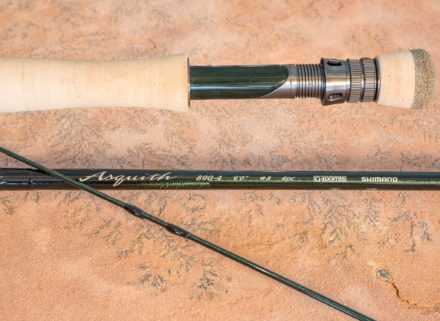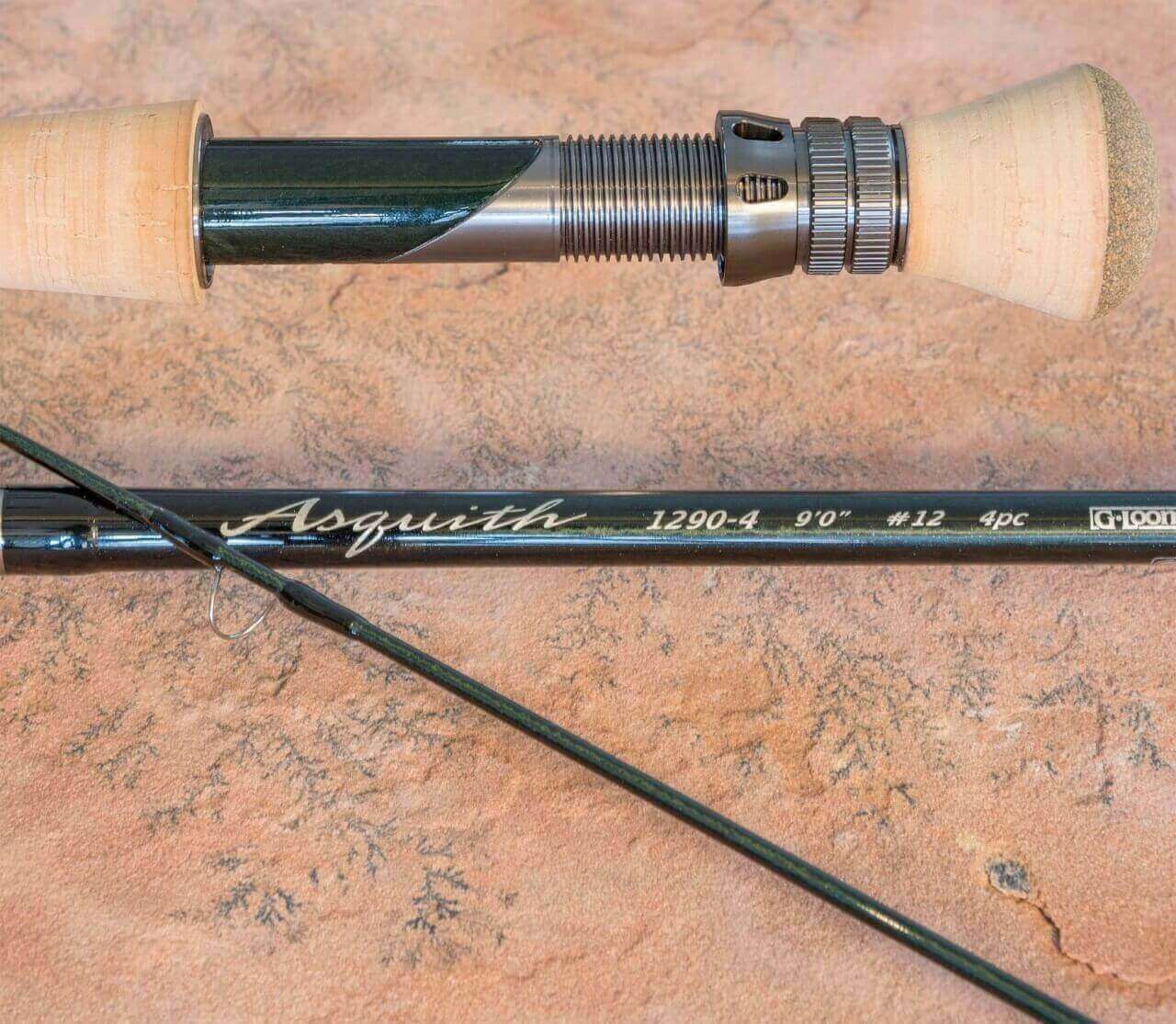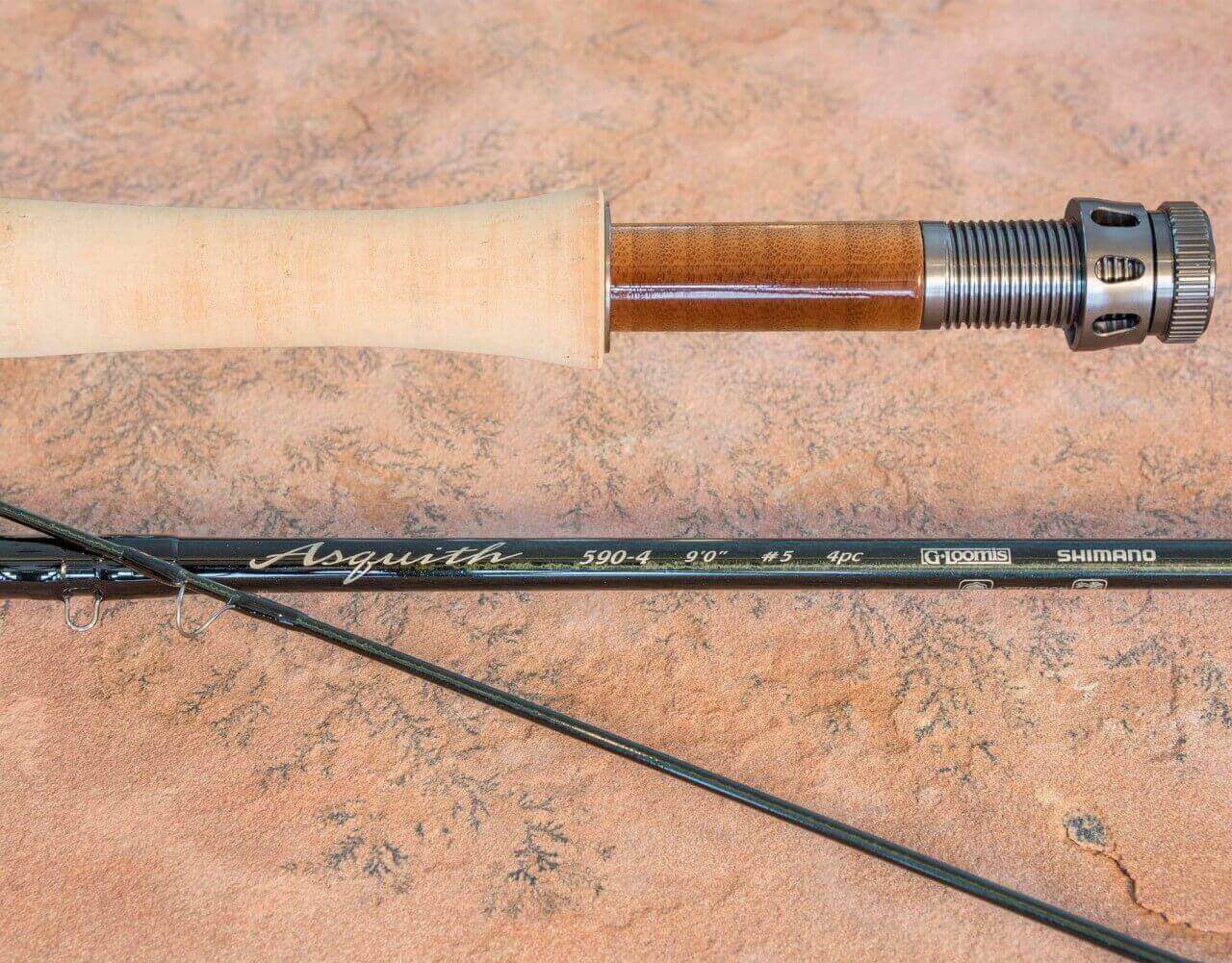
After a summary of design characteristics, read our complete casting review for all Loomis Asquith models: 490-4, 590-4, 690-4, 790-4, 890-4, 990-4, 1090-4, 1190-4, 1290-4
Design Characteristics of the G.Loomis Asquith Series
1) Line speed for all. The Asquith is a fast action fly rod with a forgiving tip and tip-mid section that engages the fly line at short distance and flexes with magnificent precision according to the length of line in the air. The caster will swing this rod with similar cadence and power whether fishing short or at great distance. The Asquith transfers more feel into the palm of the caster’s hand than its NRX cousins, and more than almost any other fast action rod on the market.
2) Consistency. This is the most cohesive family of fly rods from Loomis and one of the tightest fly rod families in the industry. Every caster will recognize the kinship between models.
3) Ideal action. Let’s call these a 7.5 out of 10 in stiffness. What’s not sweet about that?
Casting Reviews for all Models, G.Loomis Asquith Series
ASQUITH 490-4
Perhaps my favorite rod in the series, the Asquith 490-4 will be described as “perfect” by many anglers. The Asquith 490-4 exemplifies my favorite quality of the series as a whole: the basic flex profile of these rods is immaculate. There are stiffer fly rods that can cast farther and probably rods with greater torsional stability, but I have never cast a 4-weight so finely tuned to its line. Casting loops form instantly, and while it is tempting to cast for the horizon, the rod generates equal line speed and dead level loops at all distances. The swing weight is minute, the balance sensational and loop control so phenomenal it feels like you are placing the fly on target with your pinky finger. Rajeff has a legacy of fantastic 9’ 4-weights. This may be the finest rod he has ever designed.
The Asquith 490-4 will handle almost any line, but it would be a shame to fish it with a load-and-dump weight forward taper with an extra short head. Life is too short not to make a few false casts with a stick like this.
Line pairings: SA Trout Taper, Rio Gold, Rio Perception
ASQUITH 590-4
This rod is a fine fishing tool with ideal action for the all-around techniques demanded from a 5-weight. It’s fast enough to cast for great distance in the wind, but flexible enough for roll casting, line mending and fighting fish on light tippet. On the casting pond at ICAST, I played with several fly lines and found the Rio Gold to be, by far, the best choice. Lines with shorter heads seemed a little bouncy. Lighter lines, such as the Rio Lightline and SA Trout Taper, seemed a little disconnected. The Rio Gold has the combination of weight and head length to load the Asquith 590-4 and stay engaged.
Line Pairings: Rio Gold, Rio InTouch Gold, SA Stillwater
ASQUITH 690-4
In my hands, the Asquith 9’ 6-weight casts with greater loop control than power. It loads naturally with a standard WF6F line and creates easy, medium-width loops. This is an ideal action for nymphing and dry fly fishing, but perhaps not for streamers. The first word that comes to mind is “smooth.” Butt section power is sufficient for streamers and awkward nymph rigs, but this is a progressive flexing rod, the action of which differs meaningfully from that of the Sage Method or Scott Radian. This is a rod that I would “cast all day,” but not “hammer.”
Line Pairings: Rio Gold, SA MPX, SA Stillwater, Rio InTouch Sink Tip, SA Sonar Sink Tip, SA Mastery Distance
ASQUITH 790-4
Rich and I cast this 7-weight on the pond, looked at each other and struggled for the right words. What came out first was “freakshow,” followed by, “best 7-weight in the world?” This is a saltwater 7-weight to be sure, but also well suited for smallmouth, largemouth, pike and other species for which the rod’s primary purpose is pure casting. It is too short and stiff to do much roll casting or mending (anglers pursuing steelhead should choose a rod of at least 10’), but in the casting department, it can’t be beat.
Line Pairings: Rio and SA Bonefish and Redfish Tapers, SA GPX Sharkwave, Rio Gold, Rio Grand, SA MPX, Rio 15’ Sink Tips, SA Sonar Sink Tips
ASQUITH 890-4

Lines: SA Bonefish, Rio Bonefish, SA Sonar Saltwater Intermediate, Rio Grand, Rio Permit Taper
ASQUITH 990-4
This may be the “fastest” rod in the series. The Asquith 9-weight requires a saltwater style line and punchy casting stroke. With these conditions, however, it’s a truly explosive caster that creates laser loops at tremendous distance. This will be a terrific striper rod, an excellent light permit rod and the perfect choice for anglers who pack a 9-weight as a windy day savior for bonefishing. This rod and the 10-weight fish high in their line classes.
Lines: SA Bonefish, Rio Bonefish, Rio Permit, SA Sonar Saltwater Intermediate
ASQUITH 1090-4
A short, powerful stoke will drive casts with tremendous power, distance and control. Like the 9-weight Asquith, this 10-weight will fish high in its line class, an ideal rod for large permit, roosterfish, striped bass and small tarpon. Saltwater lines with slightly longer heads, such as the Rio Permit and SA Sonar Intermediate, will tap the lower portions of this fly rod and bring out the greatest power and control from the butt section. Short headed lines may cause the tip and mid sections to wobble. This rod is designed for casting deep into the blank.
Lines: SA Tarpon, SA Sonar Intermediate, Rio Permit, Rio Tarpon (classic or Tarpon Technical)
ASQUITH 1190-4
Casting this rod with an SA Tarpon Taper, my first impression was that it has greater loop control than most 11-weights. It loads easily through a really wide range of casting distances. There is spectacular power in the butt section, but it doesn’t interfere with the casting action. I notice a big difference between the NRX 11-weight and Asquith 11-wt. The Asquith has a much more integrated feel and, overall, is easier to use.
Lines: SA Tarpon Taper, SA Sonar Intermediate, Rio Tarpon, Rio Tarpon Technical
ASQUITH 1290-4

Lines: SA Tarpon Taper, Rio Tarpon, Rio Tarpon Technical, SA Sonar Intermediate Saltwater
